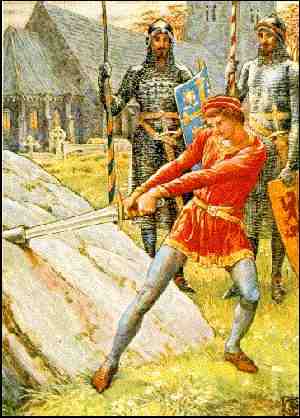AVALON
The Theosophy
King Arthur Pages

King
Arthur’s
Marriage
to Guinevere
Nennius
Historia
Brittanum
History of the Britons
800 CE
The first written mention of Arthur as a heroic
figure
The British leader who fought twelve battles
against the Anglo Saxons
The Welsh
Christian monk Nennius wrote around 800 CE the "Historia Brittanum"
(History of the Britons) which is the first work to contain a mention "
Arthur" by name as a heroic figure.
Little is
known of Nennius but was probably an early ninth century Welsh monk, and
probably did write Historia Brittonum
The work is a
strange assortment of texts
covering the
ancestries of kings, geography, the lives of saints. It mentions Julius Cæsar,
Ambrosius Aurelianus, Arthur, Patrick, and other figures. Nennius says he was a
pupil of Elbodugus
whi was Bishop
of
The Historia
Brittonum has been controversial as to its date and origin. Nennius has been
described as "unrestrainedly inventive" with this work. On the one
hand Nennius apparently had access to no-longer available 5th century sources,
but on
the other hand
can Nennius be entirely trusted as a reliable compiler of history. Apart from
his native Welsh and his clerical knowledge of Latin,
‘Nennius’
seems to have understood both Old English, and Old Irish.
Nennius made
mistakes with dating schemes, people's names and genealogical facts. However
his work is nevertheless one of the earliest records of Welsh literature and
history and his work is therefore very useful to researchers.
The work may
have in fact been compiled earlier by someone else, around the year 679. Then
additions were made in following years, and Nennius may have then re-compiled
the whole work around 800.
To complicate
matters even further, the revision of Nennius does not exist in a complete
form. The earliest existing copy is an Irish version made in the eleventh
century by Gilla Coemgin. Some of the Latin copies have extracts from the
original, including the preface of Nennius and some verses by him.
Historia
Brittanum is drawn largely upon Celtic legend, written or oral. Other writings
which have been used include Gildas, Jerome’s Chronicle and a lost life of St.
Germanus of Auxerre. Geoffrey of Monmouth was later to extensive use of it.
The brief mention
of Arthur by Nennius occurs when he describes him as being the British leader
who fought against the Anglo-Saxons. The battle culminated in a victory for the
Britons at the
lists twelve
battles with which Arthur was involved. Nennius also mentions Arthur had a dog
called Cabal, which had used to hunt boar and covers the burial site of Anir,
the son of Arthur, killed by his own father.
Nennius also
mentions Ambrosius, but not the same Ambrosius Aurelianus mentioned in the
works by Gildas and Bede. This Ambrosius was another name for the boy that
Geoffrey called Merlin. The story of Vortigern and Ambrosius (Merlin), the
falling wall and the two fighting dragons are used in Geoffrey's works.
Theosophy
Avalon

King
Arthur &
The
Round Table

Merlin
& The Tree of Life
Merlin the Magician
Born circa 400 CE ; Welsh: Myrddin;
Latin: Merlinus; English: Merlin.

The
Holy Grail
The Theosophy
King
Arthur Pages
____________________
General pages
about Wales, Welsh History
and The History
of Theosophy in Wales
Theosophy links
The Most Basic Theosophy
Website in the Universe
A quick overview of Theosophy
and the Theosophical Society
If you run a Theosophy Group you
can use this as an introductory handout.
Independent Theosophical Blog
One liners and quick explanations
About aspects of Theosophy
H P Blavatsky is usually
the only
Theosophist that most
people have ever
heard of. Let’s put that
right
The Voice of the Silence Website
An
Independent Theosophical Republic
Links
to Free Online Theosophy
Study
Resources; Courses, Writings,
A selection of articles on Reincarnation
by Theosophical writers
Provided in response to the large
number of enquiries we receive at
The Voice of the Silence Website
The Spiritual Home of Urban Theosophy
The Earth Base for Evolutionary Theosophy
Theosophical
Glossary
Published
1892
A
B
C
D
EFG
H
IJ
KL
M
N
OP
QR
S
T
UV
WXYZ
Try these if you are looking
for a
local Theosophy Group or Centre
UK Listing of Theosophical Groups
Theosophy
House
Arthurian Picture Gallery
Arthur
Marries Guinevere
Death
of Arthur
Arthur
draws the Sword from the Stone
Arthur
draws the Sword for the Stone
Guinevere
The
Lady of the
Guinevere
lends her ring to Sir Lancelot
The
Round Table
Theosophy
House
Sir
Bedivere returns Excalibur to the Lake
Sir
Galahad brought before the Round Table
Lancelot
and Guinevere
Sir
Mordred
King
Arthur
King
Arthur
Death
of Arthur
Morgan Le Fay
Theosophy
House
Merlin
instructs the young Arthur
Merlin
instructs the young Arthur
Theosophy
House



















